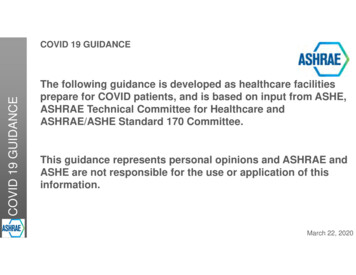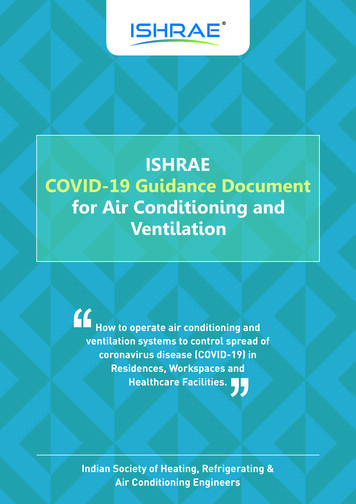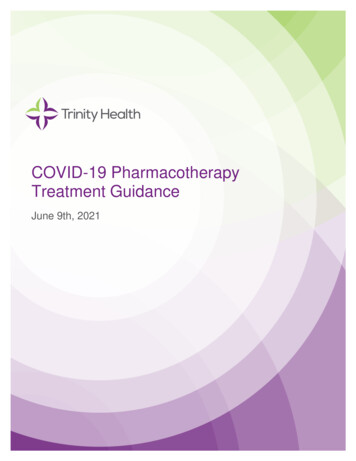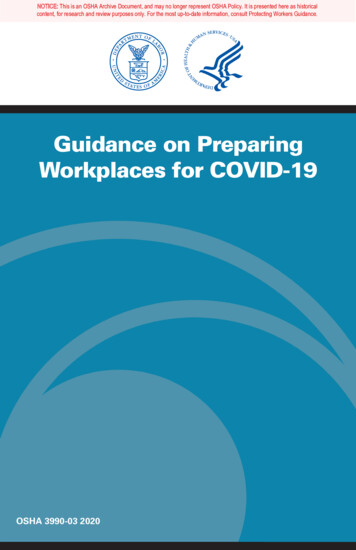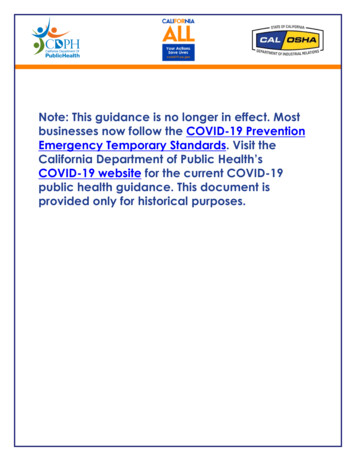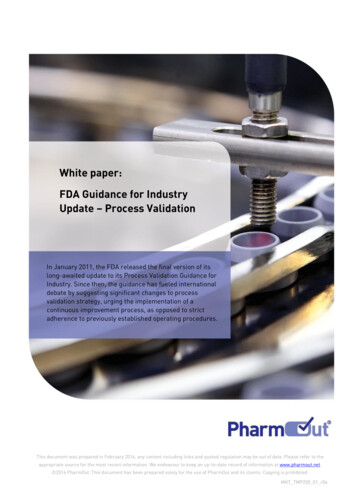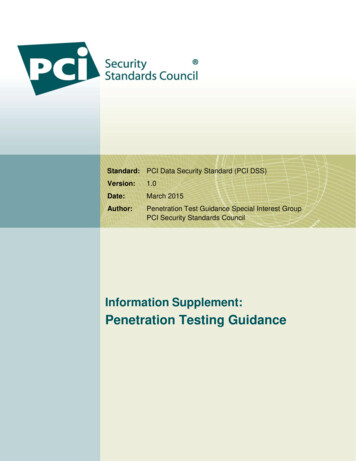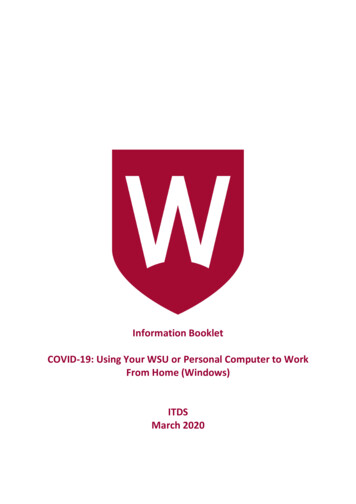
Transcription
COVID-19INDUSTRYGUIDANCE:Hair Salons andBarbershopsJuly 29, 2020All guidance should be implementedonly with county health officer approvalfollowing their review of localepidemiological data including casesper 100,000 population, rate of testpositivity, and local preparedness tosupport a health care surge, vulnerablepopulations, contact tracing, andtesting.1
OVERVIEWOn March 19, 2020, the State Public Health Officer and Director of the CaliforniaDepartment of Public Health issued an order requiring most Californians to stay athome to disrupt the spread of COVID-19 among the population.The impact of COVID-19 on the health of Californians is not yet fully known. Reportedillness ranges from very mild (some people have no symptoms) to severe illness thatmay result in death. Certain groups, including people aged 65 or older and those withserious underlying medical conditions, such as heart or lung disease or diabetes, are athigher risk of hospitalization and serious complications. Transmission is most likely whenpeople are in close contact or in a poorly ventilated area with an infected person,even if that person does not have any symptoms or has not yet developed symptoms.Precise information about the number and rates of COVID-19 by industry oroccupational groups, including among critical infrastructure workers, is not availableat this time. There have been multiple outbreaks in a range of workplaces, indicatingthat workers are at risk of acquiring or transmitting COVID-19 infection. Examples ofthese workplaces include hospitals, long-term care facilities, prisons, food production,warehouses, meat processing plants, and grocery stores.As stay-at-home orders are modified, it is essential that all possible steps be taken toensure the safety of workers and the public.Key prevention practices include: physical distancing to the maximum extent possible, use of face coverings by workers (where respiratory protection is not required) andcustomers/clients, frequent handwashing and regular cleaning and disinfection, training workers on these and other elements of the COVID-19 prevention plan.In addition, it will be critical to have in place appropriate processes to identify newcases of illness in workplaces and, when they are identified, to intervene quickly andwork with public health authorities to halt the spread of the virus.PURPOSEThis document provides guidance for hair salons and barbershops to support a safe,clean environment for workers and customers. Hair salon or barbershop owners oroperators must acknowledge that lessees should only resume operations when theyare ready and able to implement the necessary safety measures to provide for theirsafety and that of their customers. The guidance is not intended to revoke or repealany worker rights, either statutory, regulatory or collectively bargained and is notexhaustive, as it does not include county health orders, nor is it a substitute for anyexisting safety and health-related regulatory requirements such as those of Cal/OSHAor the California Board of Barbering and Cosmetology.1 Stay current on changes to2
public health guidance and state/local orders, as the COVID-19 situation continues.Cal/OSHA has more comprehensive guidance on their Cal/OSHA General Guidelineson Protecting Workers from COVID-19 webpage. CDC has additional requirements intheir guidance for businesses and employers.Required Use of Face CoveringsOn June 18, CDPH issued Guidance on the Use of Face Coverings, which broadlyrequires the use of face coverings for both members of the public and workers in allpublic and workplace settings where there is a high risk of exposure.People in California must wear face coverings when they are engaged in work,whether at the workplace or performing work off-site, when: Interacting in-person with any member of the public; Working in any space visited by members of the public, regardless of whetheranyone from the public is present at the time; Working in any space where food is prepared or packaged for sale ordistribution to others; Working in or walking through common areas, such as hallways, stairways,elevators, and parking facilities; In any room or enclosed area where other people (except for members of theperson’s own household or residence) are present when unable to physicallydistance; or, Driving or operating any public transportation or paratransit vehicle, taxi, orprivate car service or ride-sharing vehicle when passengers are present. Whenno passengers are present, face coverings are strongly recommended.Complete details, including all requirements and exemptions to these rules, can befound in the guidance. Face coverings are strongly encouraged in othercircumstances, and employers can implement additional face coveringrequirements in fulfilling their obligation to provide workers with a safe and healthfulworkplace. Employers must provide face coverings to workers or reimburse workersfor the reasonable cost of obtaining them.Employers should develop an accommodation policy for any worker who meets oneof the exemptions from wearing a face covering. If a worker who would otherwise berequired to wear a face covering because of frequent contact with others cannotwear one due to a medical condition, they should be provided with a non-restrictivealternative, such as a face shield with a drape attached to the bottom edge, iffeasible, and if the medical condition permits it.Businesses that are open to the public should be cognizant of the exemptions towearing face coverings in the CDPH Face Covering Guidance and may not exclude3
any member of the public for not wearing a face covering if that person is complyingwith the guidance. Businesses will need to develop policies for handling theseexemptions among customers, clients, visitors, and workers.4
Workplace Specific Plan Establish a written, workplace-specific COVID-19 prevention plan at everylocation, perform a comprehensive risk assessment of all work areas andwork tasks, and designate a person at each facility to implement the plan. Incorporate the CDPH Face Covering Guidance into the WorkplaceSpecific Plan and include a policy for handling exemptions. Identify contact information for the local health department where thefacility is located for communicating information about COVID-19outbreaks among workers or customers. Train and communicate with workers and worker representatives on theplan and make the plan available to workers and their representatives. Regularly evaluate the facility for compliance with the plan and documentand correct deficiencies identified. Investigate any COVID-19 illness and determine if any work-related factorscould have contributed to risk of infection. Update the plan as needed toprevent further cases. Implement the necessary processes and protocols when a workplace hasan outbreak, in accordance with CDPH guidelines. Identify close contacts (within six feet for 15 minutes or more) of aninfected worker and take steps to isolate COVID-19 positive worker(s) andclose contacts. Adhere to the guidelines below. Failure to do so could result in workplaceillnesses that may cause operations to be temporarily closed or limited.Topics for Worker Training Information on COVID-19, how to prevent it from spreading, and whichunderlying health conditions may make individuals more susceptible tocontracting the virus. Self-screening at home, including temperature and/or symptom checksusing CDC Guidelines. The importance of not coming to work:o If a worker has symptoms of COVID-19 as described by the CDC, suchas a fever or chills, cough, shortness of breath or difficulty breathing,fatigue, muscle or body aches, headache, new loss of taste or smell,5
sore throat, congestion or runny nose, nausea, vomiting, or diarrhea,ORo If a worker was diagnosed with COVID-19 and has not yet beenreleased from isolation, ORo If, within the past 14 days, a worker has had contact with someonewho has been diagnosed with COVID-19 and is considered potentiallyinfectious (i.e. still on isolation). To return to work after a worker receives a COVID-19 diagnosis only if 10days have passed since symptoms first appeared, their symptoms haveimproved, and the worker has had no fevers (without the use of feverreducing medications) for the last 72 hours. A worker without symptomswho was diagnosed with COVID-19 can return to work only if 10 days havepassed since the date of the first positive COVID-19 test. To seek medical attention if their symptoms become severe, includingpersistent pain or pressure in the chest, confusion, or bluish lips or face.Updates and further details are available on CDC’s webpage. The importance of frequent handwashing with soap and water, includingscrubbing with soap for 20 seconds (or using hand sanitizer with at least60% ethanol (preferred) or 70% isopropanol (if the product is inaccessible tounsupervised children) when workers cannot get to a sink or handwashingstation, per CDC guidelines). The importance of physical distancing, both at work and off work time (seePhysical Distancing section below). Proper use of face coverings, including:o Face coverings do not protect the wearer and are not personalprotective equipment (PPE).o Face coverings can help protect people near the wearer, but do notreplace the need for physical distancing and frequent handwashing.o Face coverings must cover the nose and mouth.o Workers should wash or sanitize hands before and after using oradjusting face coverings.o Avoid touching the eyes, nose, and mouth.o Face coverings must not be shared and should be washed ordiscarded after each shift. Information contained in the CDPH Guidance for the Use of FaceCoverings, which mandates the circumstances in which face coveringsmust be worn and the exemptions, as well as any policies, work rules, and6
practices the employer has adopted to ensure the use of face coverings.Training should also include the employer’s policies on how people whoare exempted from wearing a face covering will be handled. Ensure independent contractors, temporary, or contract workers are alsoproperly trained in COVID- 19 prevention policies and have necessarysupplies and PPE. Discuss these responsibilities ahead of time withorganizations supplying temporary and/or contract workers. Information on paid leave benefits the worker may be entitled to receivethat would make it financially easier to stay at home. See additionalinformation on government programs supporting sick leave and workers’compensation for COVID-19, including workers’ sick leave rights underthe Families First Coronavirus Response Act and workers’ rights to workers’compensation benefits and presumption of the work-relatedness ofCOVID-19 pursuant to the Governor’s Executive Order N-62-20 while thatOrder is in effect.Individual Control Measures and Screening Provide temperature and/or symptom screenings for all workers at thebeginning of their shift and any vendors, contractors, or other workersentering the establishment. Make sure the temperature/symptom screeneravoids close contact with workers to the extent possible. If requiring self-screening at home, which is an appropriate alternative toproviding it at the establishment, ensure that screening was performedprior to the worker leaving the home for their shift and follows CDCguidelines, as described in the Topics for Worker Training section above. Encourage workers and customers who are sick or exhibiting symptoms ofCOVID-19 to stay home. Hair salon or barbershop operators must provide and ensure workers use allrequired protective equipment, including eye protection, face shields, andprotective gloves when necessary. Hair salon or barbershop operators should consider where disposable gloveuse may be helpful to supplement frequent handwashing or use of handsanitizer; examples are for workers who are screening others for symptomsor handling commonly touched items. Disposable gloves should be worn for services that require them (e.g.chemical hair services). Wearing gloves should be done in conjunction withregular hand washing and is not a substitute for regular hand washing. Workers should consider using glasses, goggles, or face shields in additionto face coverings during the provision of services, particularly during face7
to face encounters. Contact customers before visits to confirm appointments and ask if they orsomeone in their household is exhibiting any COVID-19 symptoms. If thecustomer answers in the affirmative reschedule the appointment. Requestcustomers to bring and use face coverings during the visit. If appropriatefor the service, consider asking customers to come tothe salon with theirhair freshly cleaned in order to minimize time for the appointment.Customers should be asked not to bring children or others with them to theappointment. Customers should be screened upon arrival. Be prepared to cancel orreschedule customers who indicate they have any signs of illness. Display a set of guidelines for customers that are to be a condition of entry.The guidelines must include instructions to wear face coverings, use handsanitizer, maintain physical distance from other customers, and they shouldcommunicate changes to service offerings. The guidelines should beposted in clearly visible locations, including at entrances, includepictograms, and be made available digitally (e.g. through email).Cleaning and Disinfecting Protocols Coordinate with coworkers, fellow tenants, booth renters and/or workersand put a plan in place for cleaning at the beginning and end of eachshift and in between customers. Perform thorough cleaning in high trafficareas, such as reception areas, and areas of ingress and egress includingstairways, stairwells, and handrails. Frequently disinfect commonly used surfaces including credit cardterminals, counters, reception area seating, door handles, light switches,phones, toilets, and handwashing facilities. Encourage the use of credit ca
COVID-19 INDUSTRY GUIDANCE: Hair Salons and Barbershops July 29, 2020 All guidance should be implemented only with county health officer approval following their review of local
